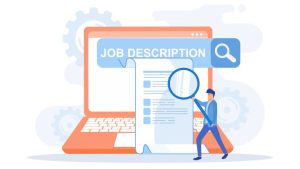Mastering The Modern Job Hunt: 5 Strategies For Job Application Enhancement
 Publié le 23 January 2024
Publié le 23 January 2024
Mastering the modern job hunt is simple and straightforward, with 5 strategies for application enhancement.
Seeking a job these days is more than just rushing to accept the first offer you receive. It is about creating a professional route for your goals, skills, and potential capabilities. You have to take charge and fight against the conventional job-hunting process in order to reach the level of success you deserve.
What does that mean?
It means you cannot rely on faceless automated application tracking systems or unskilled HR personnel. Research indicates that 75% of resumes are rejected by applicant tracking systems before they even reach a human hiring manager due to content, format, or lack of keywords. There’s more. Studies also show that more than 84% of job applications are rejected by hiring managers because they are impersonal due to a lack of customization.
Thus, taking the right steps to enhance your resume is imperative. Doing so may not only prevent your CV from being rejected but also dynamically represent your experience and expertise in a way that catches the eye of the key decision-makers in your desired organization of employment.
This blog will highlight 5 strategies for application enhancement you can employ to master the modern job hunt.
5 Strategies For Application Enhancement For Job Seekers
Obtaining a job might be an overwhelming endeavor. To improve your chances of landing your dream job, you have to employ specific tactics that make your resume stand out.
Here are the five strategies for enhancing your job application in a way that helps you surpass robotic applicant tracking systems and land an interview for your desired gig effortlessly and mastering the modern job hunt:
1. Researching The Company Thoroughly
For many job hunters in the past, thoroughly researching an organization before applying for a job was an afterthought. However, current job applicants are more careful about where they want to work and who they want to work with. They pay close attention to company culture and benefits like remote work and health perks. These factors often determine whether they would accept a job offer.
Researching your desired company thoroughly helps you understand, from the get-go, whether it is the right fit for you or not. Learn about the company’s vision, mission, values, and projects. This helps you see how your skills fit with the company’s goals. Also, employers are often impressed by candidates who show commitment and a drive to succeed.
Standing out from other applicants is also easier if you know the company’s background and principles. Show this in your application. It will also help you demonstrate a good culture fit, one that highlights aspects of your personality and work ethic that align with the organization, making you a more appealing candidate. Not to mention, you will come across as a candidate who has genuinely invested time in understanding what makes the company unique and is passionate about contributing to its growth.
Besides this, you may also end up identifying any potential red flags or issues with the company that might make you reconsider applying. It is always better to be safe than sorry in these situations. If a company doesn’t match your values or career goals, it might be better to look elsewhere.
In your research, exploring different types of companies can be enlightening. For instance, if you’re interested in the tech sector, a company like an MSP staffing company could offer unique insights into industry standards and practices. This could further enhance your understanding of the market and better prepare you for interviews and discussions.
2. Enriching Your CV With The Right Grammar, Formatting, And Keywords
Most companies today receive thousands of job applications for one single position. This has led them to use AI-enabled applicant tracking systems to sift through vast volumes of resumes and come up with the most relevant ones. This means that job seekers now have to craft their resumes in a way that gets them through an ATS seamlessly.
This is where the right grammar, formatting, and keyword insertion become important. Right grammar and clear and concise language make your application look polished and well-crafted. This makes it easier for the ATS, as well as human readers, to understand your credentials and accomplishments, which, in turn, lowers the possibility of misinterpretation.
When it comes to formatting, a clean, consistent layout with standard font and bullet points enhances the readability of your CV. This reduces the likelihood of an ATS erroneously parsing your resume and, instead, easily extracts relevant details pertaining to the job description.
Last but not least, including targeted keywords in your CV and other application collaterals is one of the most popular ways to improve a job application. Employers generally look for applicants who possess a certain set of talents. The more closely you align your target keywords with the job description, the more likely the employer will find you compelling. For example, if you’re applying for an accounting role with a heavy focus on improving efficiencies and standardization, you could include the following keyword-rich statement: “Implemented standardized templates such as receipt templates, cash flow templates, and billing statement templates, significantly enhancing operational efficiencies within the accounting department.”
In addition to this, it proves that you haven’t just submitted a generic application, which most hiring managers wouldn’t accept. Moreover, most applicant tracking systems use matching algorithms to compare the keywords in your application with the job description. Your resume will likely be flagged as a potential match if it contains the right keywords.
3. Including a Compelling Summary About Yourself
Many job applicants often overlook the significance of including an introductory section about themselves while starting the job application. This tactic is underrated but may work well in your favor in the modern job hunt because many hiring managers like to look beyond your skills and evaluate your attitude before an interview.
If you include a brief bio with your application, it will be simpler for the employer to decide whether or not you would be a good fit.
Hiring managers want to be sure you have a personality that can be easily integrated into the company culture in addition to specific talents and qualifications. You can use this section to highlight your key qualifications, career goals, and what you will bring to the table.
Tailoring your summary to match the specific job requirements you’re applying for can make for a quick and impactful introduction to your resume. It can also serve as an elevator pitch that highlights your more niche skills that can make your resume stand out.
However, writing an interesting introduction paragraph can be challenging since you need to ensure that it exhibits clarity of thought. You must avoid restating facts from your cover letter or CV since this will be interpreted as repetition and presented as bland to the hiring manager.
4. Quantifying Professional Achievements And Results
While listing job duties can give the hiring manager a good idea about what job responsibilities you have handled previously, you can take it a step further by quantifying your contributions. Yes, that’s right!
By presenting quantifiable outcomes and supporting documentation of your contributions, using percentages, figures, and metrics to showcase your professional accomplishments and results on your resume can greatly increase its effect and demonstrate the impact you have made in your previous employment. For example, if you’re applying for a role of event marketing manager, quantifying your achievements might look like this: “Increased event sponsorship by 30% compared to the previous year through tailored sponsorship emails.”
Metrics and numbers give the hiring managers concrete proof of their achievements. They provide a clear picture of your influence on teams, projects, and the organization’s overall performance. This gives your resume credibility with specific statistics to support your statements, which increases its persuasiveness to prospective employers.
Many job seekers list their previous job’s responsibilities, but few actually quantify their accomplishments. This automatically provides you with credentials you can stand out for. It also demonstrates that you actively participate in reaching goals and objectives rather than merely carrying out responsibilities. There’s more! Hiring decisions are generally heavily influenced by the results you can potentially generate for the business. Adding numbers and percentages to your achievements and contributions aligns your resume with the company’s goals and demonstrates your ability to contribute to its success.
Last but not least, quantifying your professional achievements also enhances the readability and memorability of your CV.
5. Attaching Your Social Media Handles
In the modern job hunt, social media plays a significant role in everyone’s life, and it is no exception for job hunters. Many applicants have begun including links to their social media profiles on their application collaterals as part of the recruiting process.
This is smart since most employers prefer to learn more about a candidate before considering them for a position. Creating a compelling social media resume using a platform like Instagram or LinkedIn is another excellent approach to highlight your job experience and your ability to establish a credible online presence.
By adding links to your social profile on professional networks such as LinkedIn, you give potential employers a more thorough and in-depth picture of your professional history. An up-to-date LinkedIn page that includes a professional photo, a thorough job history, and recommendations can also strengthen your candidacy. Besides this, your profile on portfolio platforms like GitHub and Behance can serve as supplementary portfolios if you are in the creative industry.
Furthermore, including social media profiles with your application gives the hiring manager more ways to reach you. Another way to incorporate your social profiles is by making a QR code that links to your social media and including the scannable code on your business cards or in your email signature. If in case your cell phone isn’t functioning, they can reach you via email or social media. It can also help you with networking opportunities, demonstrating industry expertise (either through creating content on your social profiles or participating in group discussions with other professionals in your niche), and providing employers with an avenue to verify the information provided in your CV.
Final Thoughts
Hiring managers barely spend 7 seconds scanning through every resume, which means that yours needs to create a good impression quickly to help you advance to an interview. When they see that you have demonstrated your familiarity with the business, included relevant highlights and keywords, attached your social media profiles, and presented all the information in a reader-friendly way, you automatically surpass the vast majority of talent applying for the position.
However, mastering the modern job hunt involves much more than just enhancing your job application; it involves a lot of commitment, planning, and flexibility. Besides creating a standout resume, you can improve your chances of getting your dream job by using online resources, making (and sticking) to a job searching schedule, researching companies, practicing interviews, building a strong online presence, personalizing your applications, following up with hiring managers, and accepting feedback on rejections.
These 5 strategies for application enhancement and mastering the modern job hunt, combined with a stellar CV and cover letter, can further provide you the ability to go through the job market confidently, leave a lasting impression on prospective employers, and eventually land a position that advances your career.







